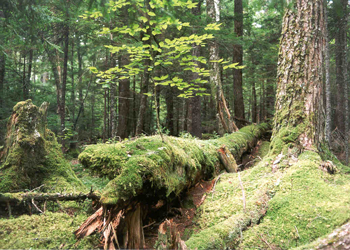 Decaying wood is an essential component of healthy forest ecosystems. Snags and coarse woody debris provide wildlife habitat, affect forest floor and streambed morphology, and contribute to nutrient cycling. Hollow trees and logs (which only form while trees are living) provide unique habitat structures, while partially decayed logs provide nursery conditions important for regeneration. Dead wood plays a critical role in changing the forest's susceptibility to fire and insect outbreaks.
Decaying wood is an essential component of healthy forest ecosystems. Snags and coarse woody debris provide wildlife habitat, affect forest floor and streambed morphology, and contribute to nutrient cycling. Hollow trees and logs (which only form while trees are living) provide unique habitat structures, while partially decayed logs provide nursery conditions important for regeneration. Dead wood plays a critical role in changing the forest's susceptibility to fire and insect outbreaks.
Nova Scotia has implemented a number of programs and regulations to help manage this valuable resource.
Links
Permanent Sample Plot Inventory
Since 1999 the PSP continuous inventory has included measurement and reporting of snags and downed coarse woody debris. Latest Report
Watercourse and Wildlife Habitat Protection Regulations
These regulations apply to all lands, Crown and private, and have three major requirements: leaving buffer strips along watercourses, leaving legacy trees in clumps, and leaving coarse woody debris in all types of forest harvesting and management activities.
Research Reports
Changes in Dead Wood Structure Following Clearcut Harvesting in Nova Scotia Softwood Forests
In addition to reporting the effect of forest harvesting on deadwood, this report provides detailed methods and formulas for measuring standing and fallen deadwood.
Selected Nova Scotia Old Growth Forests: Age, Ecology, Structure and Scoring
Reports deadwood quantities found in Acadian old growth, as well as scoresheet ranges
Coastal Forest Communities of the Nova Scotian Eastern Shore Ecodistrict
Reports deadwood quantities found in Atlantic Boreal coastal old growth